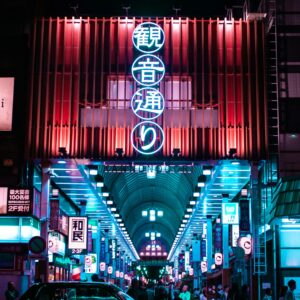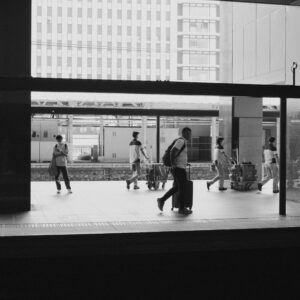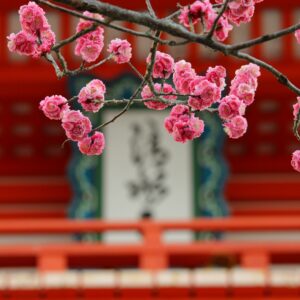The Best Places to Visit in Tokyo: Top Attractions & Landmarks
- Historical Landmarks in Tokyo
- Dynamic Urban Culture in Tokyo
- Museums in Tokyo
- Parks and Nature in Tokyo
- Shopping in Tokyo
- Culinary Delights in Tokyo
- Entertainment and Nightlife in Tokyo
- FAQs
- What is the best time to visit Tokyo?
- How can I get around Tokyo efficiently?
- What are family-friendly activities in Tokyo?
- Is it worth getting a guide in Tokyo?
- How many days do I need to see Tokyo?
- In Closing
Hey there! Welcome to Tokyo, a city where ancient traditions meet cutting-edge modernity. As your tour guide based right here in this amazing city, I’m excited to show you around. Whether it’s your first visit or you’re coming back for more, Tokyo’s bustling streets, rich cultural heritage, and endless innovation have something special for everyone. In this guide, I’ll take you through the best places to visit in Tokyo and help you make the most of your time in this vibrant city!
Historical Landmarks in Tokyo
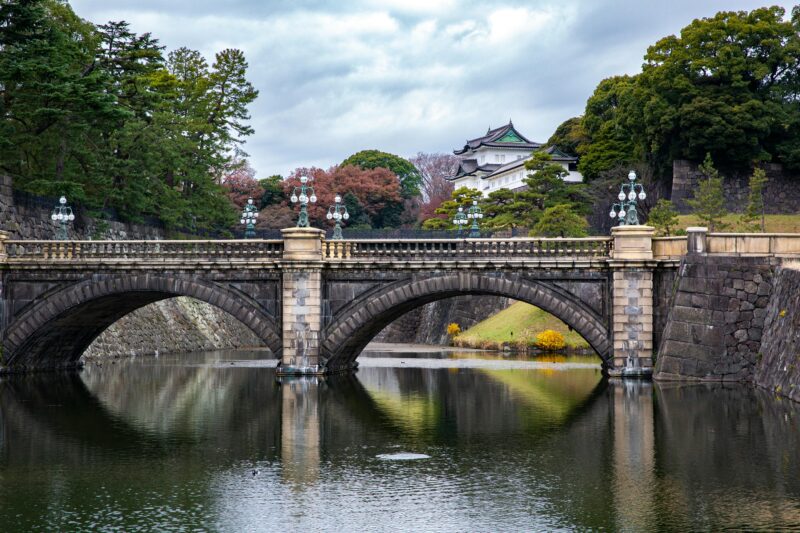
Tokyo Imperial Palace
The Imperial Palace certainly ranks in the top ten best areas in Tokyo to visit.
Located in the heart of Tokyo, head west from Tokyo Station towards Wadakura-mon Gate. Covering a little over a square kilometer, you are welcomed by 2,000 Japanese black pine trees as you enter Kokyo Gaien National Garden. The sculptural forms of the trees have made them among the most photographed aspects of the garden. Here you will see not only tourists but locals walking their dogs and families hanging out at Wadakura Fountain Park.
As you walk up to the main palace, you’ll see it is surrounded by a moat and a tremendous stunning wall. The remains of what used to be Edo Castle still maintain their mystical feeling of dominance and authority.
The castle was reconstructed after the Tokugawa shogunate and the government’s seat of power was overthrown, changing the country’s capital from Kyoto to Tokyo in 1868, and the place of residence for the imperial family was renewed to what is now called the “Koukyo”.
If you are lucky the gates on either side depending on the season will be open to visitors, mostly on weekends, allowing entry to the restricted grounds of the palace with guards and policeman standing at almost every corner instructing visitors and pointing them in the right direction.
During the Japanese bubble economy in the late 80’s, the land of the Palace was said to be worth more than all of the real estate in California combined.
Expert Tip: If you’re visiting on weekends, you might be lucky enough to catch the gates open for a rare chance to see the inner grounds. Want to explore more? Check out our Complete Tokyo Travel Guide for a full list of things to do around the palace area.
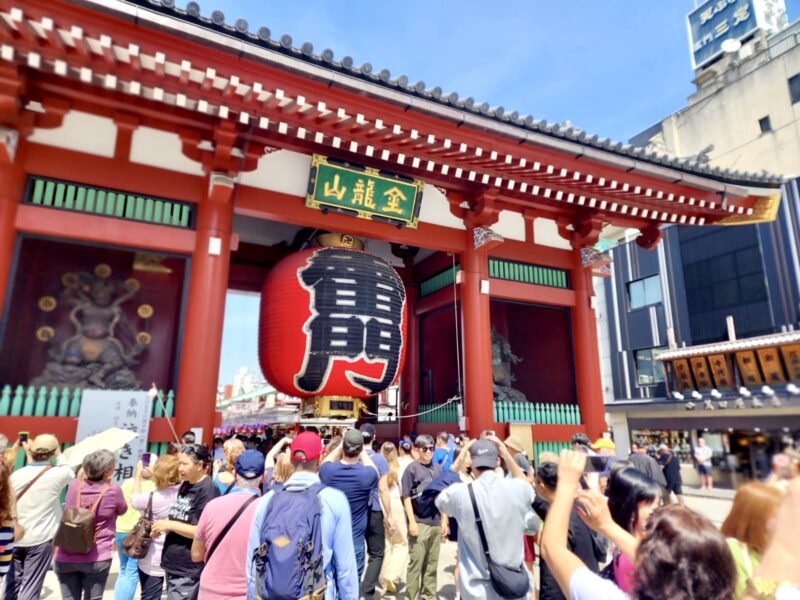
Senso-ji Temple in Asakugsa
Senso-ji, about a 20 minute drive from the Imperial Palace, is located in the vibrant Asakusa district. Considered to be Tokyo’s oldest, most significant and visited temple, Over 30 million visitors from all over the world visit each year.
Dating back to the 7th century, this temple offers a spiritual journey through beautifully preserved architecture, starting from the famous and iconic Kaminarimon Gate, which is known to be one of the most popular photo spots even among locals. At the symbolic gate, you will be welcomed by the gatekeepers, “Fujin and Raijin”, the God of Wind and the God of Thunder. As seen together in the works of art, they are amongst the most feared and respected Japanese deities.
As you pass under the enormous red lantern with the words “Kaminarimon” written in kanji characters, don’t forget to take a peek underneath the base to see the beautiful wooden carved dragon. Heading to the second gate, Hozomon Gate, visitors will walk through Nakamise-Dori, a bustling alley lined with stalls and little shops that offer traditional crafts, snacks, and souvenirs.
As you swim through the crowd of people, don’t forget to stay on the left side of the traffic or you’ll find yourself fighting through a swarm of vigorous shoppers. Once you arrive at the main hall, you’ll come upon a splendid incense burner surrounded by a large group of visitors called Jokoro. The sacred smoke is said to cleanse the body and symbolizes healing.
Climbing the stairs into the temple’s main complex called “Hondo”, you can walk up to the beautiful golden chancel and give offerings followed by a short prayer. After leaving the main hall if you hang a left you can enjoy walking through the garden to see other smaller halls and the five-storied pagoda up close. Originally built in the year 942, according to legend it is said to contain the ashes of Buddha.
Dynamic Urban Culture in Tokyo
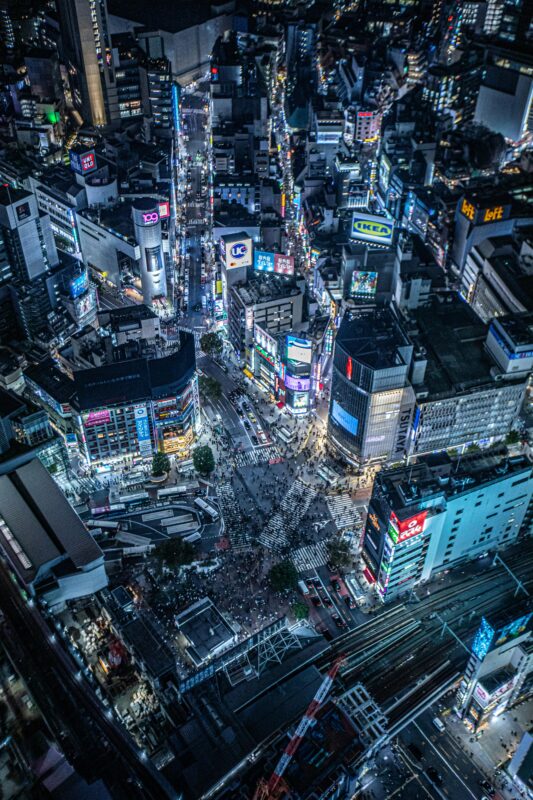
Shibuya Crossing
Shibuya Crossing, a famous and iconic scramble styled pedestrian crossing is the busiest pedestrian crossing in the world with an average of 2.4 million people crossing a day, it is said that 2500 people cross at one time!
With splashy lights and large electronic billboards, anyone visiting for the first time can catch a glimpse and remember maybe their favorite movie or show using this area.
The famous Hachiko statue, one of the most popular meeting points in the city, sits right outside the station and a must-see if you’re a fan of the book or movie.
Surrounding Shibuya Station is an area for fashion, entertainment, and a hub for nightlife, drawing both locals and tourists to experience its’ ceaseless energy firsthand.
If you’re a fan of Mario or Luigi, you should take a ten-minute stroll northwest of the crossing until you come across a department store called Parco, which has a variety of anime and hobby shops including Pokemon Center and the world famous Nintendo Store on the sixth floor.
Check out 15 Unique Things to Do in Tokyo: Discover Offbeat Activities for more inspirations on experiencing the city like a local.
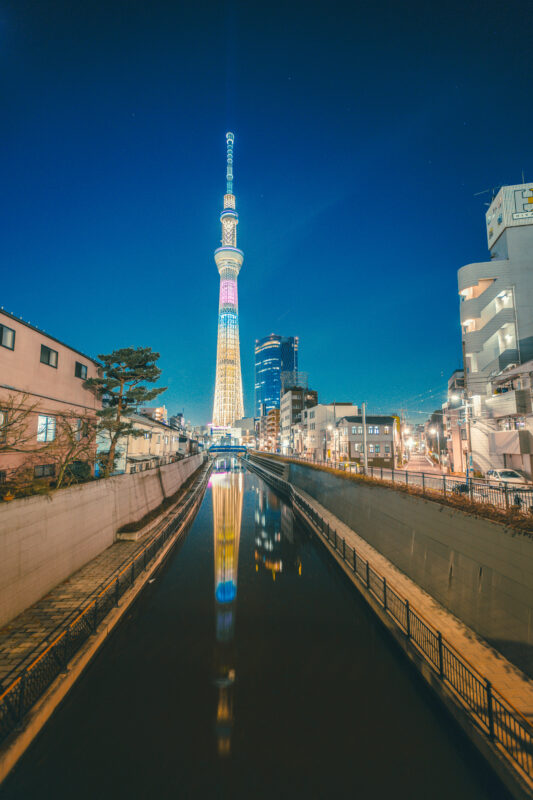
Tokyo Skytree
Tokyo Skytree, Only a five-minute drive from Asakusa Temple, is the tallest tower in Japan at 634 meters tall. Opened May 22nd, 2012, it not only serves as a television broadcasting tower but also as a vantage point offering breathtaking panoramic views of Tokyo’s sprawling cityscape. It features observation decks at various points, with the highest at 450 meters, providing visitors with a unique perspective on the city below.
Make sure you reserve your tickets online ahead of time or you’ll be waiting in line for over an hour on a busy day just to purchase the tickets. Once purchased, the wait to get the top isn’t as bad. Four shuttle elevators, that hold a capacity of 40 persons, rocket to the “Tembo Deck” (350m in height) in 50 seconds with maximum speeds of 600m per minute! A second set of elevators connects the Tembo Deck to the 450 meter high Tembo Galleria, consisting of a sloping spiral ramp. Inside the bottom of the complex includes a shopping mall, aquarium, and numerous dining venues, making it a nice entertainment spot.
Fans of Pokemon can go to the 4th floor and visit Pokémon Center Sky Tree Town. Inside are also vast amounts of nice restaurants and cuisine, in an area called Tokyo Solamachi, for you foodies out there.
For a family-friendly experience at Skytree, head over to Pokemon Center Skytree Town on the 4th floor after your visit.
Want to know more about traveling in Tokyo with kids? Check out our Things to Do in Tokyo with Kids guide.
Museums in Tokyo

Edo-Tokyo Museum
Dive deep into the rich history of Tokyo at the Edo-Tokyo Museum, located in the Ryogoku district. It was built in 1993 to preserve Edo’s cultural heritage, and features city models of Edo and Tokyo between 1590 and 1964.
It was the first museum built dedicated to portray Tokyo’s evolution from the Edo Period through to contemporary times. Featuring life-size replicas of Nihonbashi Bridge, a kabuki theatre, and a traditional Edo period street, the museum offers interactive and an enchanting experience that bring the history of Tokyo to life for visitors of all ages.
It consists of eight floors, the first floor being a museum shop, restaurants, and a ticket counter. Now operated by the Tokyo Metropolitan Foundation for History and Culture, the museum contains a permanent and non-permanent exhibition hall that include the rich history and culture of Edo (Tokyo). Examples of past exhibitions are displays of Excavations, Ukiyo-e Paintings, Old Japanese Folk Music and even artifacts from the Jomon period, 10,000 years ago in Japan, reflecting back on the civilization and culture of the city of Edo.
There are lectures and events if you’re interested in deepening your knowledge of specific areas of the museum.
Note: Closed for renovation from April 2022 until 2025
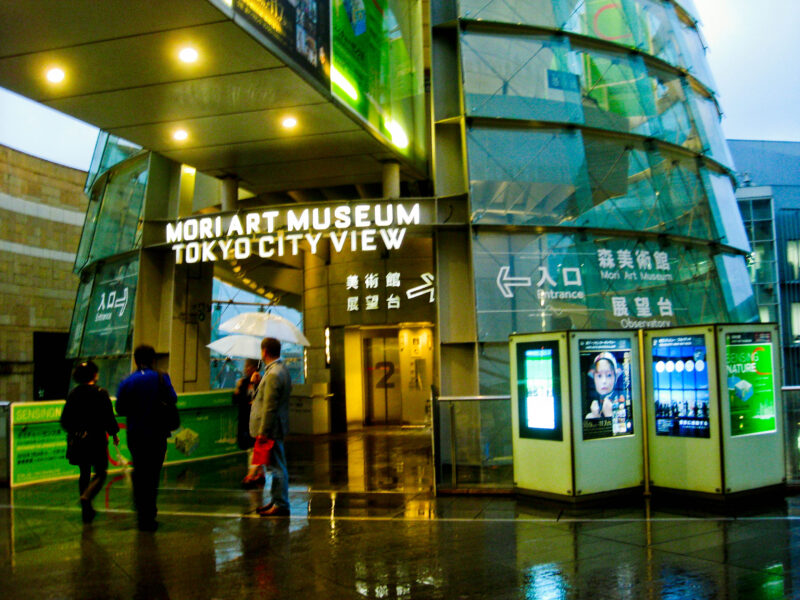
Mori Art Museum
The Mori Art Museum, a coetaneous art museum founded by the real estate developer Minoru Mori an influential business tycoon, is situated atop the Mori Tower in the humming streets of Roppongi Hills, is a cornerstone for contemporary art in Asia.
Since opening in 2003, the Mori Art Museum has held exhibitions featuring a number of internationally renowned artists from Japan and beyond, including Anish Kapoor, Bill Viola, Yayoi Kusama, Cao Fei, Ai Weiwei and Jeff Koons. One of Tokyo’s more popular art museum had attracted some 2.3 million visitors from more than 160 countries around the world on the year of the opening.
The museum’s exhibitions focus on modern art and emerging cultural trends, featuring innovative works from renowned artists. During the evening visitors can also relish the beautiful view of city lights that create a mesmerizing backdrop of the stunning views of Tokyo.
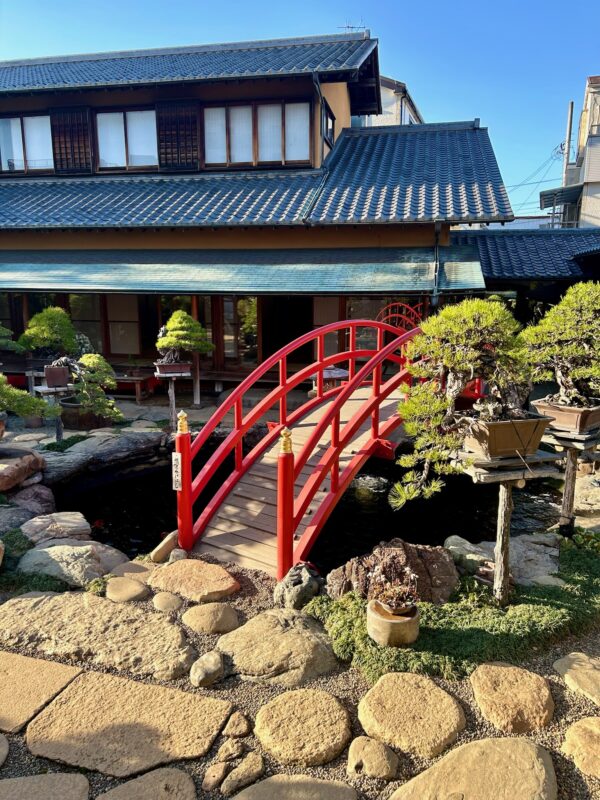
Shunkaen Bonsai Museum
A hidden gem located in the Edogawa District is the Shunkaen Bonsai Museum. Founded by bonsai master, Kunio Kobayashi in 2002, attracts 10,000 foreign visitors from all over the world each year.
Wanting to spread the beauty of bonsai worldwide, he has opened his own place of residence to the public and has over 1,000 different displays of marvelous bonsai you can enjoy from.
As you enter the grounds a humble Japanese man will greet you at the entrance and customers will be required to pay a 1,000~6,000 yen fee depending on the course that you are looking for.
If you want the full experience it is highly recommended to partake in the “Bonsai Experience Class” which is a one hour session that comes with an English speaking guide and teacher that allows you to sit down and participate in making your bonsai after a brief lecture. The standard course is favorable as well.
As you are welcomed by English speaking guide / student, Joseph, he will take you around the courts of the property on a one-hour tour of the entire facility. After being introduced to the infamous 1,000 year old bonsai and its neighbor, the million dollar bonsai, you will be guided into the tokonoma alcove where you will take you shoes off and enter the sensei’s home. After the tour is finished, customers will be appointed to sit down inside the “Osetsuma” the drawing room where the sensei’s “Okusama” or his wife, will serve Japanese green tea.
The room is exhibited with other work of the Sensei’s and his awards throughout that past are displayed on the walls for you to enjoy. Since the facility has no time limit, customers are not rushed into leaving so anyone can sit down and enjoy chatting over a cup of tea, and glance over some of the books the Sensei has written which includes photographs of his past work, and if you’re lucky enough the Bonsai Master himself could be present on that day.
Parks and Nature in Tokyo

Ueno Park
Considered one of the best places to go in Tokyo even amongst the locals is Ueno Park. Established in 1873, it is Tokyo’s largest and most beloved public parks because of its variety and abundance of things to do such as museums, a zoo, and a performance hall within its expansive grounds.
Exceptionally famous for its breathtaking “Sakura” or cherry blossoms in spring, the spacious park attracts millions of visitors each year. Its vast lawns, shady paths, and tranquil ponds offer a peaceful retreat from the urban environment, making it an ideal spot for relaxation and leisure.
If you’re into museums you have the choice of visiting Tokyo National Museum, National Museum of Nature and Science, National Museum of Western Art, Tokyo Metropolitan Art Museum, Tokyo National Museum The Heiseikan, Shitamachi Museum, Ueno Royal Museum and list goes on. The grounds’ also known for the establishment of Seiyoken, one of the first western-style restaurants in Japan in 1872.
If you’re an animal lover visit Ueno Zoo, the home of the famous Giant Panda Shin-Shin and her two adorable little baby twins Shoa-Shoa and Lei-Lei born June 23, 2021.
After a long days of travel you can join the locals for a drink at Ueno’s Ameyoko Shopping district which is walking distance from the park to either blow off steam or do some nice shopping at the open-air market.
Are you foodie? Check out Tokyo Food Guide: Must-Try Dishes and Best Restaurants to savor the best of Tokyo cuisine.
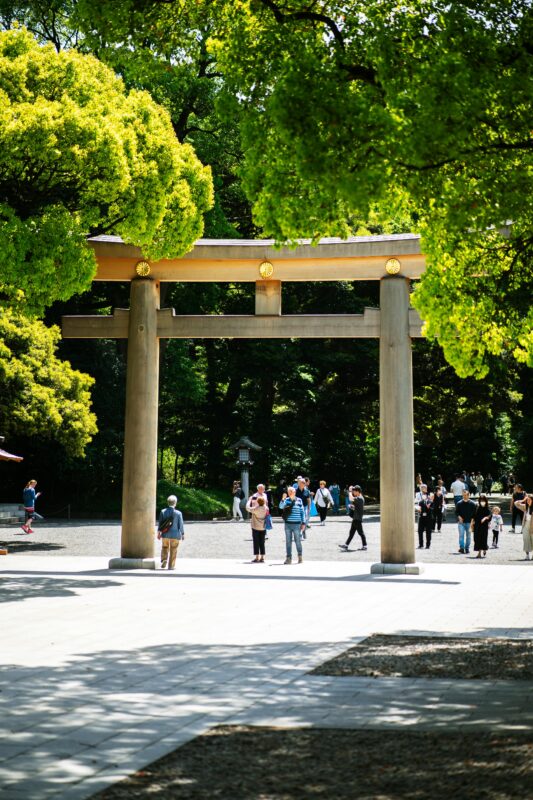
Meiji Shrine and Yoyogi Park
Seven minutes’ drive north of the Shibuya Scramble Crossing is the South Entrance of Meiji Shrine and Yoyogi Park, Tokyo’s largest park sitting at 134 acres of land. The park is known for gatherings and events throughout the year such as farmers market, flea market, Asian culture festival, music festival, Brazilian festival, and family fitness events.
Considered a great place for families to take their kids or just couples looking to go on a date. Adjacent to the park is Meiji Jingu or Meiji Shrine, one of Japan’s most popular shrines and the best places to go in Tokyo. Built in 1920 to commemorate the death of the Meiji Emperor and Empress Shoken, has millions of visitors every year and 3 million alone just the day of Hatsumode, the year’s first prayers. The government decided to build the shrine 8 years after the passing of the emperor receiving donations from all over Japan.
The large forested area which it shares with its adjacent neighbor, Yoyogi Park, was actually man made and consists of 120,000 trees with 365 different species. Sitting in the heart of the Tokyo, when visited it has a unique and mystical feel to it leaving behind what was just a city of massive skyscrapers and concrete.
The difference between a Buddhist Temple and a Shinto Shrine, which is a religion originated in Japan, is the Torii Gate at the entrance. As you enter the gate don’t forget to bow once in front of the “Torii” to pay your respects. It is even more respectful as you are leaving the grounds to turn around towards the main shrine and bow once again at the end.
The grounds are split into two different sections, the “Naien” and “Gaien”, or the inner and the outer areas of the garden. As you walk up to the main hall follow these rituals and you’ll get an even more exciting experience of the whole thing. At the temizuya water pavilion located usually by the entrance, visitors are encouraged to wash of your hands and mouth of any bad spirits purifying your body and mind before proceeding to stand in front of the deity. Scoop up water with the provided ladle and rinse your hands and mouth (one scoop covers all three steps).
After that you may proceed to the “Saisen-bako” or offering box, to throw your coin in and do your prayers. Different again from the Buddhist Temple, this time take two bows two claps one bow and state your full name, address, your appreciation, and then your wish. Be lucky enough to catch a traditional Japanese wedding ceremony or Sumo event that takes place every year.
Don’t forget to buy your amulets and write your wishes on the back of the wooden votive tablets before you leave!
Shopping in Tokyo
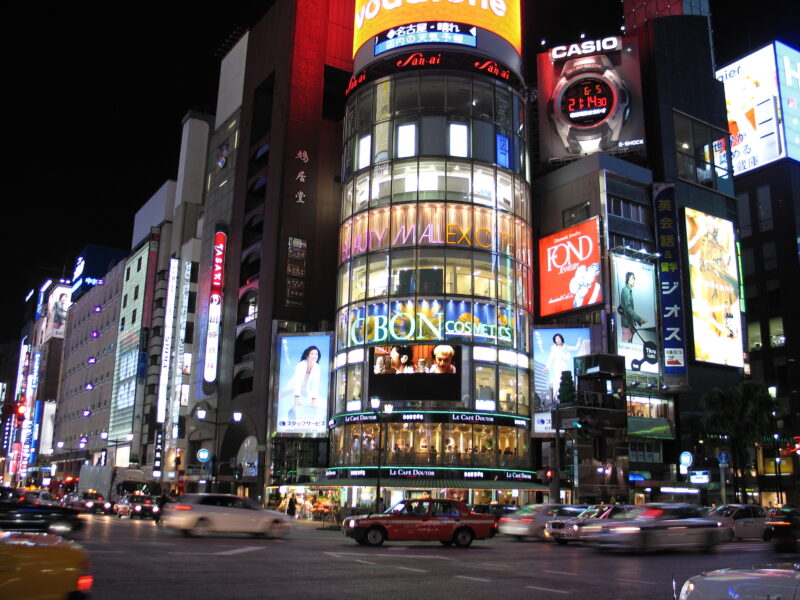
Ginza: A Luxury Shopping Experience
Ginza, Tokyo’s premier shopping district and the Fifth Avenue of Japan, embodies the pinnacle of luxury and elegance. Here, iconic Japanese department stores like Mitsukoshi and Ginza Six embrace high-end boutique shops that also line the streets of Ginza, offering an unparalleled shopping experience. Beyond retail, Ginza is a cultural hotspot, featuring fine arts galleries, upscale dining, and theaters, making it a must-visit for those looking to indulge in high culture and sophistication.
The famous street Chuo-dori, or center street, is closed to cars on weekends due to high traffic of people and a place to come if you’re looking for a unique experience. It is highly recommended that if you are in Japan during November to January, you come to Ginza for the Christmas illuminations and walk through “Chuo-dori”.
If you are interested in traditional kabuki-theater, Kabuki-za would be the place to visit in Tokyo. A must see theatrical experience that was originally built in 1889 and seats 1,964 people. If you know your elegance, Tadashi Shoji or Tasaki should be on your list of places to go.
Love to shop? Check out Best Shopping Areas in Tokyo: Top Districts & Markets to find the latest fashion and unique souvenirs.

Harajuku: Takeshita Street
Located in the heart of Harajuku, Takeshita Street is the epicenter of Tokyo’s cute or “kawaii” culture and youth fashion. This pedestrian-only street is lined with trendy boutiques, unique accessory stores, and fast-fashion outlets that appeal to the younger crowd.
It’s also a great place to sample street food, including crepes and flamboyant cotton candy, making it a vibrant spot for those looking to either experience the cutting edge of Tokyo’s fashion scene or just there to snap the right picture to post on your Instagram.
Access is quite easy coming off the train of JR Harajuku Station, or if you being dropped off by a taxi or with a tour guide, many will stroll into this area after leaving Meiji Shrine. Travelers will be standing taking photos of the “Takeshita-Dori” camera equipped sign at the entrance. The bustling streets of Harajuku can be hectic on a busy day so if you’re walking around with a crepe be cautious or SPLAT!

Old Tsukiji Fish Market
The Tsukiji Outer Market or Old Tsukiji Fish Market continues to thrive as a bustling hub for fresh seafood and traditional Japanese cuisine, even after the relocation of the inner wholesale market. It remains a favorite among locals and tourists for its lively atmosphere and variety of foods, including fresh and grilled seafood, and other Japanese delicacies such as Wagyu Beef on a stick.
Located in Chuo-city, Tokyo, Tsukiji is still one of the sought after places to visit in Japan, even after the relocation to Toyosu in 2018. Although the tuna auction and the wholesale fish market has moved, a lot of the old buildings and outer street food vendors still remain so do not worry.
Visitors usually are astounded by the cleanliness of the outdoor food vendors. Guides always receive compliments on how sanitary the facilities are, and even the travelers who don’t prefer seafood, mention how there is no fishy smell throughout the market.
If you have time visit Tsukiji Hongwanji Temple right next door to cleanse off any fishiness left over with the incense burning in the front as you walk in and on a right day you can sit beside the Chancel to take the load off. But just remember to be very quiet and respectful, and no photographs!
Culinary Delights in Tokyo
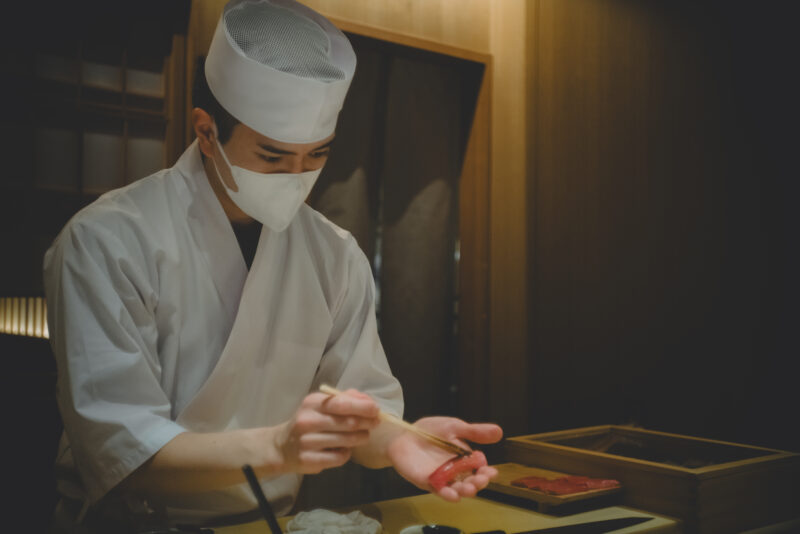
Sushi Dining at Exclusive Restaurants
Tokyo is globally renowned for its sushi, and dining at an exclusive sushi bar in Tokyo offers an intimate glimpse into the artistry and tradition of sushi making. These venues often feature counter seating where diners can watch skilled sushi chefs at work, using techniques passed down through generations to create exquisite pieces of sushi from the freshest ingredients.
If you’re feeling spontaneous or its your first time and you don’t know what to order, consult your private guide or just google “Omakase” which translates to Chef’s recommendation, and have them prepare everything for you by surprise.
Want to learn more about Tokyo’s food scene? Check out our full Tokyo Food Guide for must-try dishes and restaurant recommendations.
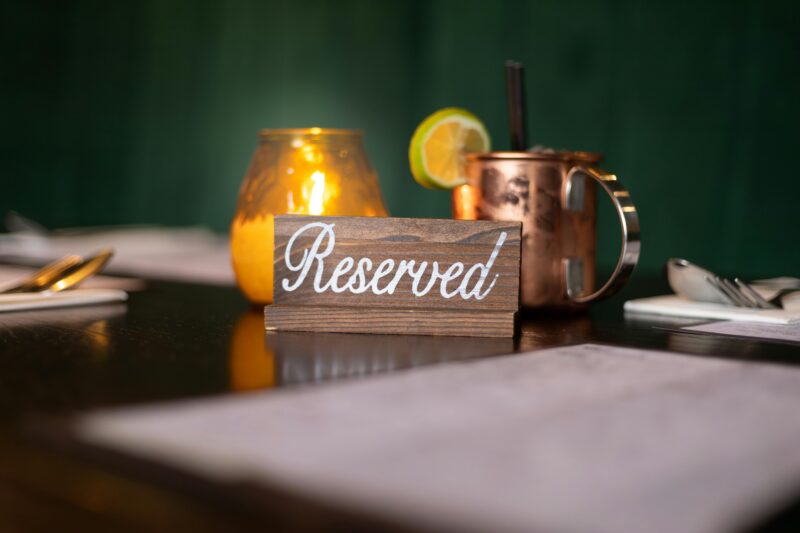
Michelin-Starred Restaurants
Tokyo holds the record for the most Michelin-starred restaurants in any city, recently passing Paris, illustrating its status as a world-leading culinary capital. These restaurants offer a gastronomic adventure ranging from traditional Japanese kaiseki dinners to innovative fusion cuisine, each prepared with meticulous care to offer a memorable dining experience. Don’t forget to make your reservations.

Street Food in Tokyo
The street food scene in Tokyo is both vibrant and diverse, offering everything from takoyaki (octopus balls) and yakitori (grilled chicken skewers) to sweet treats like “taiyaki”.
Apart from your traditional treats, you’ll find every once in a while, coming across strawberry candy on a stick, Wagyu Beef on a stick, cheesy corndogs, 10 yen pans, and your non-traditional sweets of all sorts.
Exploring street food is a great way to provide you with a good sense of feeling of the country you are visiting and can become a delicious way to experience Tokyo’s dynamic food culture. Going to Old Tsukiji Fish Market is highly recommended.
Entertainment and Nightlife in Tokyo
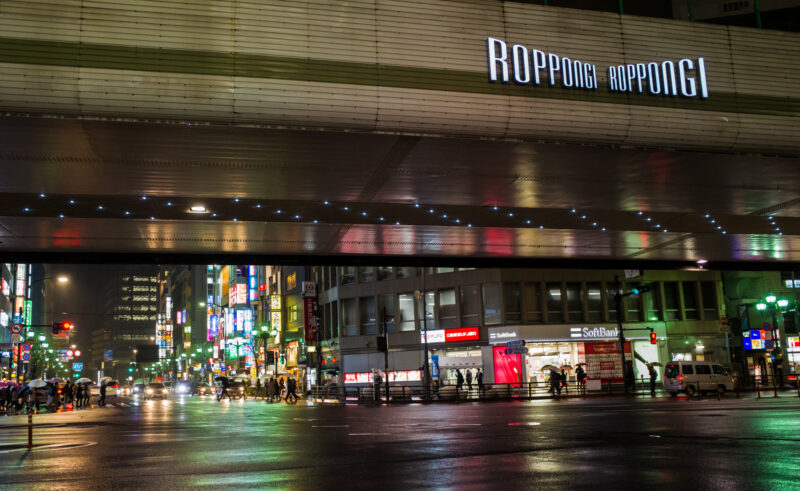
Roppongi's Vibrant Nightlife
Roppongi is one of Tokyo’s most popular nightlife districts, known for its mix of nightclubs, bars, and live music venues. What used to be considered number one most expensive place to live in Japan, is still pretty high on the list.
Roppongi’s night life attracts a diverse crowd, from expats and tourists to locals, all looking to enjoy an exotic evening. The area’s vibrant energy makes it a prime destination for those seeking to experience Tokyo’s nightlife.
Check out Tokyo Nightlife Guide on how to experience the city’s vibrant nightlife, from hidden speakeasies to lively nightclubs.

Kabukicho: Tokyo's Entertainment Heart
Kabukicho, located in Shinjuku, is one of Tokyo’s most infamous entertainment districts. Despite its reputation as a red-light area, it’s also packed with legitimate entertainment choices, including movie theaters, restaurants, and themed bars, making it an exciting area to explore after dark.
Depending on what your preferences are, Ni-Chome might be it, a buzzing neon-lit atmosphere that houses multiple LGBTQ bars and nightclubs along the strip.
FAQs
What is the best time to visit Tokyo?
The best time to visit Tokyo is during the spring (March to May) when the cherry blossoms are in bloom, or during the autumn (September to November) when the weather is cool and the leaves are changing colors.
How can I get around Tokyo efficiently?
Tokyo boasts one of the world’s most efficient public transportation systems, including subways, trains, and buses. The widespread use of English signs and announcements makes navigation relatively easy for tourists.
What are family-friendly activities in Tokyo?
Tokyo offers numerous family-friendly activities, from exploring Disneyland Tokyo and DisneySea to visiting educational museums and interactive exhibits. Ueno Zoo and the many public parks also provide great family entertainment.
Is it worth getting a guide in Tokyo?
Yes. Hiring a guide in Japan can greatly enhance your experience, especially if you want in-depth knowledge of cultural sites, local customs, and hidden gems. A guide can help you navigate language barriers and provide personalized recommendations, making your trip more enjoyable and insightful.
How many days do I need to see Tokyo?
To fully explore Tokyo’s main attractions, plan for at least 3 to 5 days. This gives you enough time to visit popular sites like Shibuya, Asakusa, and Shinjuku, while also allowing for one-day trips to nearby destinations like Nikko or Kamakura.
